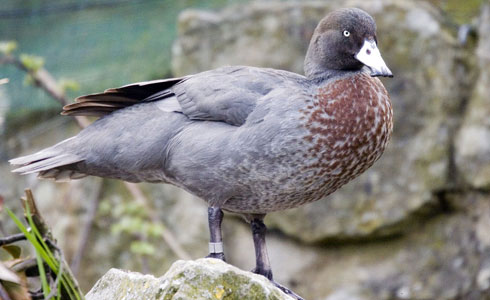Hymenolaimus malacorhynchos (blue duck, whio)
Hymenolaimus malacorhynchos, the blue duck or whio is the only member of the genus Hymenolaimus. It is a slate-blue colour and has a characteristically pale bill.
It is one of only 3 species amongst the world’s 159 waterfowl that live all year round on fast-flowing rivers. The others are found in South America (the torrent duck) and New Guinea (Salvadori’s duck).
This duck’s presence indicates a healthy river - it acts as a key indicator species of river quality.
Hymenolaimus malacorhynchos is endemic to New Zealand where the Maori name whio (pronounced fee-o) describes the high-pitched, wheezy whistle call that is made by the male.
Hear the blue duck's call on the New Zealand Department of Conservation's website.
Blue duck populations are declining because of habitat loss, predation and human activity. It is now a protected species.
Species detail
-

Taxonomy
The blue duck is unlike any other duck. It is the only member of its genus and has no close relatives. Find out more about its unusual appearance.
-

Distribution
The blue duck is endemic to New Zealand where it lives on fast-flowing mountain rivers. Find out more.
-

Biology
Blue ducks nest in secluded sites near the river. Both parents care for the young, and the birds can live for up to 7 years. Find out more.
-

Behaviour
Blue ducks are creatures of habit. They follow a daily routine, do not migrate, and defend their territory for a life-time. Discover how they spend their time and what they like to eat.
-

Conservation
Blue duck populations are declining and the species is classified as endangered. Find out what threatens this duck and what can be done to protect it.
-
References
Get reference material for Hymenolaimus malacorhynchos.
Images

Hymenolaimus malacorhynchos.
© zabdiel
Hymenolaimus malacorhynchos.
© zabdiel, Creative Commons Attribution 2.0 Generic license
Hymenolaimus malacorhynchos.
© Karora
Hymenolaimus malacorhynchos.
© Martin, Creative Commons Attribution-NonCommercial License - Version 2.0About the author
A word from the author
"The blue duck is a truly unique species. Its physical adaptations and habits are like no other duck. Endemic to New Zealand and only found on mountain rivers, its numbers are declining. Its presence indicates a ‘healthy’ river and they are therefore a key indicator species of river quality. For these reasons alone every effort should be made to secure the future of this remarkable and charismatic species."

